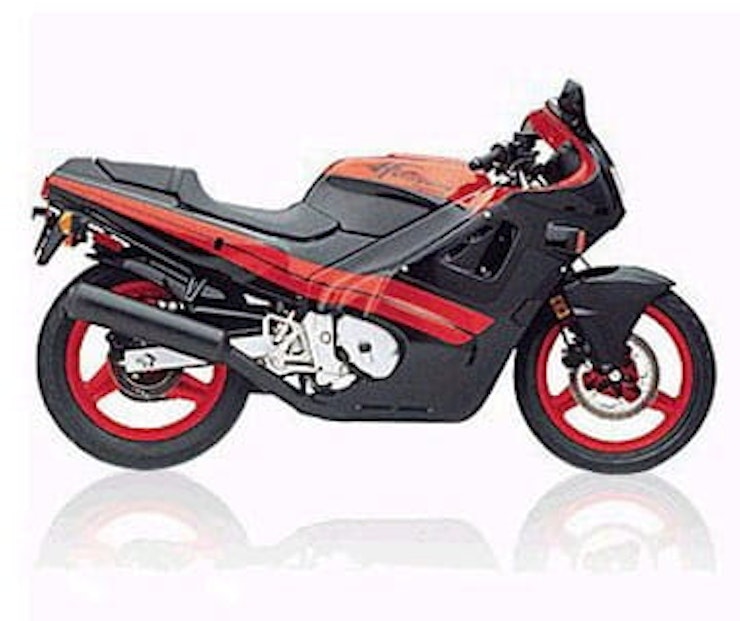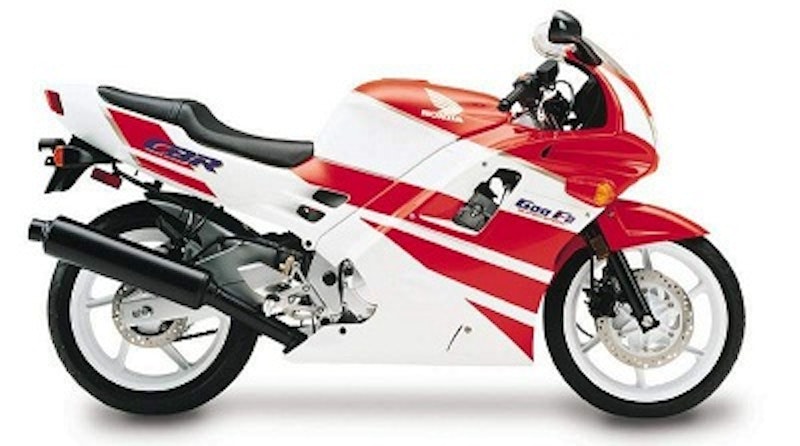Author: Jon Urry Posted: 15 Jan 2013
This year Honda’s iconic CBR600 celebrates its 26th birthday. With a glass of bubbly in our hands, Bike Social looks back and charts the generations of the bike that helped defined the modern supersport era…
The first generation: 1987 - 1990
CBR600F-H/J and updated K/L
The CBR600F first appeared in 1987 and quickly gained the nickname ‘jelly mould’ due to its all-encompassing fairing. Behind the plastics a box-section steel frame held a brand new 16-valve inline four water-cooled engine that produced a GPz600R (the top dog in 1987 with 75bhp) beating 82bhp and weighed 13kg less than the Kawasaki. Standing for City Bike Racing, the CBR’s motor was tilted forward 35-degrees to improve the bike’s weight distribution and also ran a 3mm larger bore and 5.6mm shorter stroke than the Kawasaki to allow it to rev higher and produce more power. And the technology didn’t stop there, the CBR had Honda’s TRAC anti-dive 37mm forks, 17-inch three spoke wheels, a hugger as standard and a 147mph top speed! In 1989 the CBR was updated (F-K and F-L models) with larger carbs increasing power to a claimed 84bhp, rebound adjustment added to the shock and slight styling mods.
Specs
Engine: 598cc, inline four, 16v, DOHC
Bore x stroke: 63 x 48mm
Power: 82bhp @ 11,000rpm
Torque: 43ftlb @ 8,500rpm
Weight: 182kg
The way forward: 1991 – 1994
CBR 600F-M/N and updated P/R
After four years at the top, Honda faced tough competition from the likes of the Kawasaki ZZ-R600 and Yamaha FZR600 and so the CBR received a complete re-design. A new steel twin-spar chassis housed a completely revised engine with an increased capacity (ok, it’s only 1cc) and a new bore and stroke. In the pursuit of even more power, Honda increased the CBR’s bore by 2mm and once again shortened its stroke. The resulting 8bhp and 3ftlb may not sound like much, but when combined with the new, and slightly less ugly, fairing and stiffer 41mm forks made the CBR a force to be reckoned with once again. Despite increasing the CBR’s sporty side, Honda never took its eye off the ‘real world practicalities’ of its bike and the F remained the best selling 600 thanks to this balance between sport and useable. The updated P/R models featured upgraded forks with rebound adjustment and tiger stripe graphics!!!
Specs
Engine: 599cc, inline four, 16v, DOHC
Bore x stroke: 65 x 45.2mm
Power: 90bhp @ 11,500rpm
Torque: 46ftlb @ 10,500rpm
Weight: 185kg
Times they are a changing: 1995 – 1998
CBR600F-S/T and updated V/W
The mid-1990s wasn’t a great period for the CBR as it faced a barrage of competition from the likes of the newly released Kawasaki ZX-6R and Yamaha Thundercat, both of which were sportier than the Honda. In order to squeeze a few more bhp from the motor, Honda added its own Ram Air system to the CBR in 1995 along with bigger 36mm carbs and a new steel chassis with an updated swingarm allowing for a larger 160/60 rear wheel. Although many regard this as the definitive steel framed CBR (steely) the fact of the matter is that while the CBR continued to sell well, riders were increasingly drawn to the sportier middleweights. Honda attempted to close the gap a bit in the 1997 update by improving the Ram Air and making the rear seat unit a bit narrower, however it was pretty obvious that something drastic needed doing to the CBR…
Specs
Engine: 599cc, inline four, 16v, DOHC
Bore x stroke: 65 x 45.2mm
Power: 105bhp @ 12,000rpm
Torque: 49ftlb @ 10,500rpm
Weight: 186kg
Framing heck! 1999 – 2000 CBR600F-X/Y
As the 20th century drew to a close, Honda decided to arm the updated CBR with a brand new chassis that would help it regain its spot at the top of the supersport tree. The aluminium beam frame added a whole new, and much needed, dimension of sporty prowess to the CBR while a revamped engine with a 2mm larger bore and reduced stroke further boosted performance. However while the engine was kicking out a claimed 110bhp, the biggest change to the CBR was a reduction in weight as the new chassis helped it shed a whopping 18kg. This weight loss, combined with a far stiffer chassis, new 43mm fully-adjustable forks, four-piston brake calipers and a 180-section rear tyre hinted at a move towards the track for the CBR. An impression the new bolt-on subframe only enhanced…
Specs
Engine: 599cc, inline four, 16v, DOHC
Bore x stroke: 67 x 42.5mm
Power: 110bhp @ 12,500rpm
Torque: 48ftlb @ 10,500rpm
Weight: 168kg
Injection of performance: 2001 to 2006
CBR600F – 1/2/3/4/5/6 & CBR600FS – 1/2 Sport
2001 saw the CBR gain a whole fresh new look with twin headlights replacing the old single headlight look, however the most important development happened behind the fairing. For the first time in its history the CBR came with PGM-FI fuel injection instead of good old fashioned carbs, although the claimed power was unaffected and remained at 110bhp. But better was to come…
Alongside the CBR600F, Honda also unveiled an uprated version, the CBR600FS Sport. Designed to give Honda a shot at the World Supersport title, the Sport came with dual valve springs, a split rider/pillion seat, a lighter fly wheel and altered cams. The first CBR race replica was now available to buy, it was almost as if Honda were gauging the public’s reaction to transforming their traditional workhorse into a thoroughbred racer…
Specs
Engine: 599cc, inline four, 16v, DOHC
Bore x stroke: 67 x 42.5mm
Power: 110bhp @ 12,500rpm
Torque: 48ftlb @ 10,500rpm
Weight: 168kg
Race replica: 2003-2006
CBR600RR-3/4 & updated 5/6
In 2003 the supersport battle was no longer a small skirmish, it was full-on nuclear Armageddon! First Kawasaki pushed the red button (or should that be green button) with the radical ZX-6R B1, which even had a homologation special brother, before Honda unleashed the CBR600RR. Billed as a mini-RCV, the CBR lived up to its promise. Handling like a 250GP bike thanks to a brand new chassis that included a Unit-Pro link swingarm (just like the RCV) and underseat exhaust, the RR also came with a banshee of an engine. With bottom end sacrificed in search of power the RR was as far from the traditional ‘all-rounder’ CBR philosophy as you could get. It screamed and wailed its way to a dizzying (claimed) 117bhp at a valve-bouncing 13,500rpm. Mad, bad and stunning when pushed hard on track, Honda had made their point and returned the CBR to the top of the pile. The RR was updated in 2005 with the addition of radial brakes, inverted forks and a tiny bit of much-needed midrange.
Specs
Engine: 599cc, inline four, 16v, DOHC
Bore x stroke: 67 x 42.5mm
Power: 117bhp @ 13,500rpm
Torque: 49ftlb @ 11,000rpm
Weight: 169kg
Race replica mark two: 2007 - 2012
CBR600RR
Responding to owner’s comments about the missing mid-range, Honda updated the CBR600R in 2007 with a new look and engine. The fairing gained a central air scoop while the inline four motor suddenly discovered a bit of grunt. Where it had been hiding was still a mystery, however what mattered was that it was back and once again the CBR powered to the forefront of rider’s minds. A claimed dry weight of 156kg was more than a little optimistic by Honda, however the new motor, which was physically smaller than before, came with lightened internals allowing it to rev faster and produce that elusive mid-range as well as power. In 2009 Honda equipped the CBR with its C-ABS system, an ABS system that alters the pressure between front and rear calipers in an attempt to steady the bike and keep it level under braking.
Specs
Engine: 599cc, inline four, 16v, DOHC
Bore x stroke: 67 x 42.5mm
Power: 119bhp @ 13,500rpm
Torque: 50ftlb @ 11,000rpm
Weight: 156kg (claimed…)
Return of the king: 2011 – current
CBR600F
After Honda launched the 2003 CBR600RR the writing was always on the wall for the CBR600F and in 2006 the bike dropped out of production. But that didn’t stop an army of CBR fans wishing for it to return – their dreams were answered in 2011. The CBR600F aims to bridge the gap between the aggressive RR and the naked Hornet 600 and provide a practical and affordable motorcycle with sporting performance that isn’t over the top. In essence Honda have returned to the very roots of the CBR that made it so popular to start with. Using a re-tuned RR engine and an aluminium backbone chassis with inverted forks and CBS with ABS braking , the CBR600F is a commuter with a sporty edge rather than a full-on supersport machine. A sad end to a great line of ground breaking supersport bikes? Not at all, the RR still exists for those wanting a bit more aggression in their CBR, while the F is a superb day to day machine. It’s a true City Bike, if not a City Bike that Races.
Specs
Engine: 599cc, inline four, 16v, DOHC
Bore x stroke: 67 x 42.5mm
Power: 101bhp @ 12,000rpm
Torque: 47ftlb @ 10,500rpm
Weight: 198kg (kerb)
The future:
2013 CBR600RR
Despite the decline in the supersport market, Honda took the decision to update the CBR600RR for 2013. Although limited to fairly small upgrades, the alterations are none the less significant. New Showa Big Piston forks and 12-spoke cast aluminium wheels are claimed to deliver a smoother road ride while also enhancing the CBR’s track performance. The Unit Pro-Link shock has been refined and a new ECU map has optimized power and torque for a better throttle response. These features, when combined with the stylish new look, should be enough to ensure that the CBR’s future is secure for a few more years. Although who knows, could we see an electric CBR ruling the roost in another 26 years time?
Specs
Engine: 599cc, inline four, 16v, DOHC
Bore x stroke: 67 x 42.5mm
Power: 119bhp @ 13,500rpm
Torque: 50ftlb @ 11,000rpm
Weight: 196kg (kerb)

